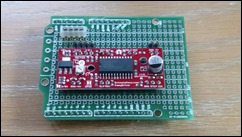So in my last post, I mentioned I was going to build this DIY equatorial mount for photography and general viewing of the skies. I am using an Arduino UNO board as the controller for the device, which will drive a stepper motor to open and close the “door”. I purchased an EasyDriver card to interface between the Arduino and the stepper motor. I attached it to a shield card I already had for prototyping with the UNO and brought power and motor connections out to pins. The power for the motor and the Arduino will both come from a car starter/air compressor that has a 12VDC auxiliary port. The stepper motor came for the surplus house I mentioned before and is by Oriental Motor in Japan. So far, I have gotten all three parts connected together and have run the motor through some operations that show that I should be able to do the job with it.
I had also obtained a lead screw at the surplus store but have not been able to find a source for a lead screw nut to travel on it. The best source I could find for parts like I want to use for driving the door is parts that are designed for 3D printers. I took a chance and ordered some parts that should be able to work and they should arrive in the next week or two, so I should know how they will work when I write the next installment.
I will probably fabricate the hinging parts for the door since standard hinges may have too much play for the stability I will want. I think I can make some fairly accurate parts in the wood shop we have here, where I can use a drill press to make some nice, tight parts using wood and metal. The base door parts will be made with oak for a nice, hard surface and I have an old, sturdy tripod that should be able to hold the whole apparatus securely.
I have been running some spreadsheets looking at the calculation of the stepping timing for the door to make it match the sidereal angle of the earth. The geometry of the device determines that the speed of the stepping motor needs to vary as the door opens so as to maintain a constant platform. A formula can be easily derived for the stepping frequency and other implementations I have read about have used formulas and tables to minimize the error in the angle. However, I have come to realize that the computational speed of the Arduino processor is fast enough to be able to compute the next step interval well before the interval needs to occur, so accuracy should not be a problem assuming that my formula is correct and that I accurately position the device lined up on Polaris.
Next time I will show you the geometry of the device I am building, the formula I am using to determine the step intervals and, hopefully will know if the hardware I am getting for the stepper will work. Then I can get busy fabricating the platform



